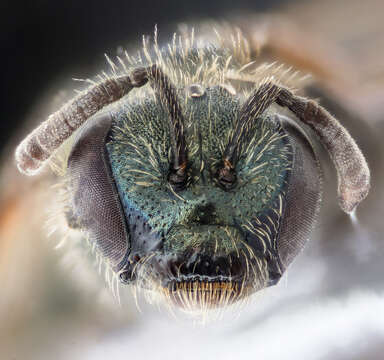Lasioglossum tenax, f, North Carolina, face_2020-12-18-18.24.52 ZS PMax UDR

Description:
Lasioglossum tenax. A northern species, in general, but this particular one found at the southern edge of its range in the mountains of North Carolina. Range-wise you will find (if you were to look) L. tenax from Newfoundland to Alaska and down the spine of the Rockies where it stops about the same latitude as it does in Appalachia. The food for this bee, of course, is pollen, which, if you recall, comes from flowers. Now then, the flowers in Appalachia are for sure unsimilar to those in Alaska and the Rockies. So, does that mean L. tenax is unpicky about its pollen? Probably not, probably, as is suspected for most of these Dialictusy Lasioglossums, they should be generalists. All sorts of pollen should be ok. So, then what limits them? Why, for example, don't they hang out in Fort Lauderdale, Austin, or Petaluma? And why are there so many of these Lasioglossum generalists running around in the same place? Why don't they just compete each other up? Maybe there is just so much pollen out there that multiple generalists can co-exist on the same food sources? What exactly is the niche here for these things? So many Lasioglossum species just should not exist in one place, (metaphorically this is similar to the apocryphal story that bumbles should theoretically should not be able to fly). Why are we going to Mars when we can't even figure out the Lasioglossum problem? 8 "?"s today. Might be a record. ~~~~~~~~~~{{{{{{0}}}}}}~~~~~~~~~~ All photographs are public domain, feel free to download and use as you wish. Photography Information: Canon Mark II 5D, Zerene Stacker, Stackshot Sled, 65mm Canon MP-E 1-5X macro lens, Twin Macro Flash in Styrofoam Cooler, F5.0, ISO 100, Shutter Speed 200 We Are Made One with What We Touch and See We are resolved into the supreme air, We are made one with what we touch and see, With our heart's blood each crimson sun is fair, With our young lives each spring impassioned tree Flames into green, the wildest beasts that range The moor our kinsmen are, all life is one, and all is change. - Oscar Wilde You can also follow us on Instagram - account = USGSBIML Want some Useful Links to the Techniques We Use? Well now here you go Citizen: Best over all technical resource for photo stacking: www.extreme-macro.co.uk/ Art Photo Book: Bees: An Up-Close Look at Pollinators Around the World: www.amazon.com/Bees-Up-Close-Pollinators-Around-World/dp/... Free Field Guide to Bee Genera of Maryland: bio2.elmira.edu/fieldbio/beesofmarylandbookversion1.pdf Basic USGSBIML set up: www.youtube.com/watch?v=S-_yvIsucOY USGSBIML Photoshopping Technique: Note that we now have added using the burn tool at 50% opacity set to shadows to clean up the halos that bleed into the black background from "hot" color sections of the picture. www.youtube.com/watch?v=Bdmx_8zqvN4 Bees of Maryland Organized by Taxa with information on each Genus www.flickr.com/photos/usgsbiml/collections PDF of Basic USGSBIML Photography Set Up: Google Hangout Demonstration of Techniques: plus.google.com/events/c5569losvskrv2nu606ltof8odo or www.youtube.com/watch?v=4c15neFttoU Excellent Technical Form on Stacking: www.photomacrography.net/ Contact information: Sam Droege sdroege@usgs.gov 301 497 5840
Included On The Following Pages:
- Life (creatures)
- Cellular (cellular organisms)
- Eukaryota (eukaryotes)
- Opisthokonta (opisthokonts)
- Metazoa (Animal)
- Bilateria
- Protostomia (protostomes)
- Ecdysozoa (ecdysozoans)
- Arthropoda (arthropods)
- Pancrustacea
- Hexapoda (hexapods)
- Insecta (insects)
- Pterygota (winged insects)
- Neoptera (neopteran)
- Endopterygota (endopterygotes)
- Hymenoptera (wasps, bees, and ants)
- Apocrita (wasp)
- Aculeata
- Apoidea (bees & apoid Wasps)
- Anthophila (bee)
- Halictidae (sweat bees)
- Halictinae (sweat bee)
- Halictini
- Lasioglossum (sweat bees)
- Lasioglossum tenax
This image is not featured in any collections.
Source Information
- license
- cc-publicdomain
- copyright
- USGS Bee Inventory and Monitoring Lab
- photographer
- USGS Bee Inventory and Monitoring Lab
- original
- original media file
- visit source
- partner site
- USGS Bee Inventory and Monitoring Lab
- ID


